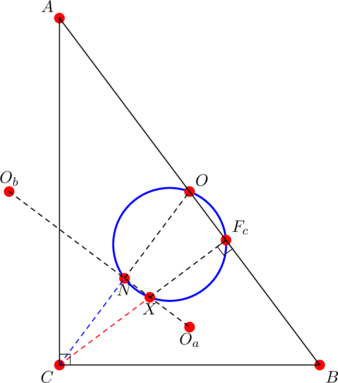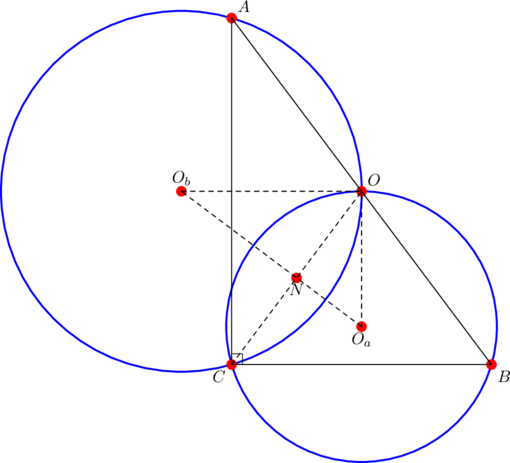- can be built from any non-isosceles right triangle
- contain a pair of
 angles facing each other
angles facing each other - combine some properties of right kites with some properties of quasi-harmonic quadrilaterals.
Thus, they are special.
Partial proofs
Throughout we work with a non-isosceles right triangle ![]() in which
in which ![]() .
. ![]() and
and ![]() denote the circumcenter and nine-point center.
denote the circumcenter and nine-point center.
To see a basic construction of such a cyclic quadrilateral, take any non-isosceles right triangle ![]() in which
in which ![]() . Denote its circumcenter by
. Denote its circumcenter by ![]() , its nine-point center by
, its nine-point center by ![]() , and its circumradius by
, and its circumradius by ![]() . Consider triangles
. Consider triangles ![]() and
and ![]() with circumcenters
with circumcenters ![]() and
and ![]() . Let the segment
. Let the segment ![]() intersect the altitude from
intersect the altitude from ![]() at point
at point ![]() . Then the quadrilateral
. Then the quadrilateral ![]() , with
, with ![]() the foot of the altitude from
the foot of the altitude from ![]() , is cyclic.
, is cyclic.

Consider the convex quadrilateral ![]() in the diagram below:
in the diagram below:

The interior angles at ![]() and
and ![]() are both
are both ![]() , while the interior angles at
, while the interior angles at ![]() and
and ![]() are
are ![]() and
and ![]() .
.
If the parent triangle is isosceles, the altitude ![]() coincides with the median
coincides with the median ![]() , in which case
, in which case ![]() is just a line.
is just a line.
Indeed, ![]() , and both are equal to
, and both are equal to ![]() , where
, where ![]() is the circumradius of the parent triangle
is the circumradius of the parent triangle ![]() .
.
Since ![]() as stated, the nine-point center
as stated, the nine-point center ![]() is the midpoint of segment
is the midpoint of segment ![]() . Triangles
. Triangles ![]() and
and ![]() both contain the segment
both contain the segment ![]() . Thus
. Thus ![]() are co-linear because they all lie on the right bisector of
are co-linear because they all lie on the right bisector of ![]() .
.
Takeaway
Let ![]() be an acute triangle with circumcenter
be an acute triangle with circumcenter ![]() and circumradius
and circumradius ![]() . Further, let
. Further, let ![]() and
and ![]() be the diameters of the circumcircles of
be the diameters of the circumcircles of ![]() and
and ![]() . Then the following statements are equivalent:
. Then the following statements are equivalent:
 is a right triangle in which
is a right triangle in which 
- the identity
 holds.
holds.
In case the parent triangle ![]() is obtuse, we have the following analogous equivalence:
is obtuse, we have the following analogous equivalence:
- the side-lengths
 satisfy
satisfy 
- the identity
 holds.
holds.
Task
- (Inverted squares) Let
 be a right triangle in which
be a right triangle in which  , the circumcenter is
, the circumcenter is  , and the circumradius is
, and the circumradius is  . PROVE that:
. PROVE that:
- the diameters
 and
and  of the circles
of the circles  and
and  are related to
are related to  via an inverted Pythagorean identity:
via an inverted Pythagorean identity:
(1)


(The relation in (1) also holds when the parent right triangle is isosceles, but the quadrilateral
 degenerates in that case. More on this later.)
degenerates in that case. More on this later.)
- the diameters
- (Impossible situation) Let
 be a right triangle in which
be a right triangle in which  , and let
, and let  and
and  be as in the discussion.
be as in the discussion.
- Find a condition under which a circle centred at
 will be externally tangent to the circle
will be externally tangent to the circle  as in the diagram
as in the diagram

- PROVE that if the circumcircles of
 and
and  touch externally, then
touch externally, then  .
. - Deduce that it is impossible for the circumcircles of
 and
and  to touch externally.
to touch externally.
- Find a condition under which a circle centred at

